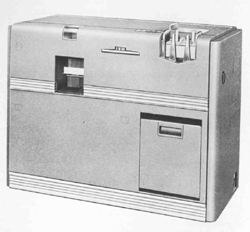IBM Calculators

Here is a table of IBM's automatic calculators; click on the links to visit pages about specific models:
| Type | Name | Introduced | Repertoire | Remarks |
|---|---|---|---|---|
| 601 | Multiplying Punch | 1931 | (mechanical) First IBM calculator that could multiply. | |
| Aberdeen | Pluggable Sequence Relay Calculator | 1944 | (relays) Advanced machine for WWII work. | |
| 602 | Calculating Punch | 1946 | (mechanical) First commercial IBM calculator that could divide. | |
| 602-A | Calculating Punch | 1948 | "A 602 that worked". | |
| 603 | Electronic Multiplier | 1946 | The first electronic calculator (vacuum tubes). | |
| 604 | Electronic Calculating Punch | 1946 | Hundreds times faster than the 601-602. | |
| 605 | Electronic Calculator | 1949 | (vacuum tubes) The "CPU" of the Card-Programmed Calculator. | |
| 607 | Electronic Calculating Punch | 1953 | Like a 605 with more memory (there was no 606). | |
| 608 | Calculator | 1953 | The first all-solid-state computing machine. | |
| 609 | Calculator | 1960 | A faster 608 with more memory. | |
| 610 | Auto-Point Computer | 1957 | True floating point; interactive, programmable, the first "personal computer". |
The 610 is listed because IBM placed it next in line in its 600 series, but in fact it is quite a different species. Unlike the others, it is a standalone self-contained computer. Rather than cards for I/O, it has a keyboard, a CRT, and a printing typewriter, plus paper tape.
The demand for greater flexibility and capacity during the decade from 1946 to 1956 brought forth the Card Programmed Calculator (a 604 or 605 combined with a tabulator, card punch, and memory) and then true stored-program computers such as the SSEC, NORC, 650, and 701, which IBM still called "calculators", perhaps so as not to cause the many human computers to fear for their jobs. In the mid-1950s, the preferred term became "data processing system".
Tabulators, Sorters, Key Punches, Collators, Reproducers, Interpreters.